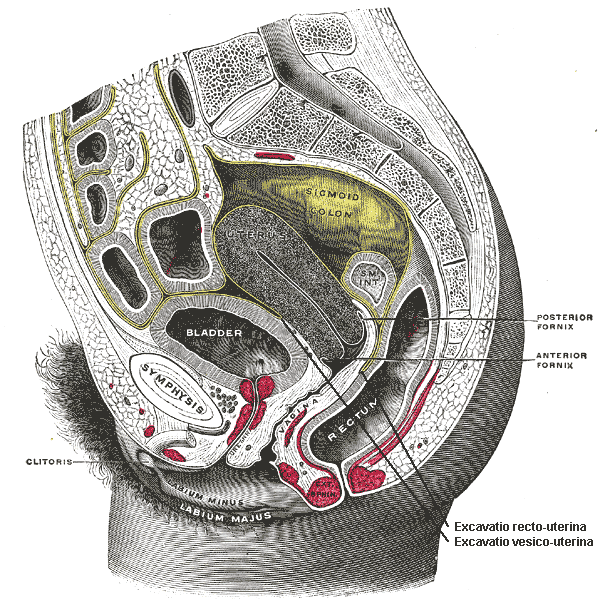MeSH A01.047.025.600.225 TA A10.1.02.512 | Dorlands
/Elsevier e_18/12347073 FMA 14728 | |
 | ||
Latin excavatio rectouterina, cavum douglassi, fossa douglasi | ||
The recto-uterine pouch, also known by various other names, is the extension of the peritoneal cavity between the rectum and the posterior wall of the uterus in the female human body.
Contents
Structure and physiology
In women it is the deepest point of the peritoneal cavity, posterior to (behind) the uterus and anterior to (in front of) the rectum. (The pouch on the other side of the uterus is the vesico-uterine pouch.) It is near the posterior fornix of the vagina.
It is normal to have approximately 1 to 3 ml (or mL) in the recto-uterine pouch throughout the menstrual cycle. After ovulation there is between 4 and 5 ml of fluid in the recto-uterine pouch.
In men, the region corresponding to the recto-uterine pouch is the recto-vesical pouch, which lies between the urinary bladder and rectum. (There is no equivalent to the vesico-uterine pouch).
Pathology
The recto-uterine pouch, being the lowest part of the peritoneal cavity in a woman at supine position, is a common site for the spread of pathology such as ascites, tumour, endometriosis, pus, etc.
Naming and etymology
The recto-uterine (or rectouterine) pouch is also called the recto-uterine (or rectouterine) excavation, utero-rectal (or uterorectal) pouch, recto-vaginal (or rectovaginal) pouch, pouch of Douglas (after anatomist James Douglas, 1675–1742), Douglas pouch, Douglas cavity, Douglas space, Douglas cul-de-sac, Ehrhardt–Cole recess, Ehrhardt–Cole cul-de-sac, cavum Douglasi, or excavatio rectouterina. The combining forms reflect the rectum (recto-, -rectal) and uterus (utero-, -uterine).
In Obstetrics and Gynecology, it is most commonly referred to as the posterior cul-de-sac.
The Douglas fold (rectouterine plica), Douglas line, and Douglas septum are likewise named after the same James Douglas.
Culdotomy
A culdotomy or posterior colpotomy is an incision or needle puncture of this "cul-de-sac" pouch by way of the vagina.
Clinical significance
As it is the furthest point of the abdominopelvic cavity in women, it is a site where infection and fluids typically collect.
The recto-uterine pouch is used in the treatment of end-stage renal failure in patients who are treated by peritoneal dialysis. The tip of the dialysis catheter is placed into the deepest point of the pouch.
